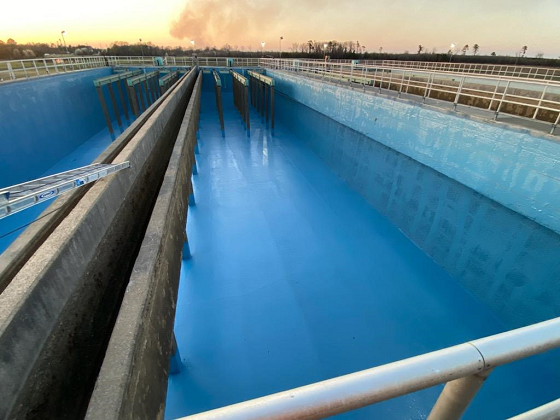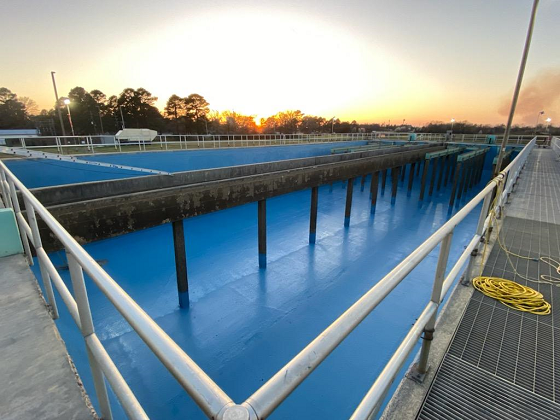In 2018, Induron Protective Coatings teamed up with Texarkana Water Utilities (TWU) to develop specifications for several of their uncoated and aging settling basins, which were in critical need of refurbishment. After several discussions, reviewing the basins’ conditions, and working within regulations unique to the Northeast Texas region, specifications for refurbishing the settling basins were put into place.
Two of the three basins, including one job conducted in early 2022, were completed by Missouri-based contractor Thomas Industrial Coatings. As part of this partnership, Induron recommended contractors to the client and stayed available to them as a technical support resource throughout the project.
“I have had the privilege of working with Don Thomas, the owner of Thomas Industrial Coatings, and his team even before he launched his company back in 1991,” said Paul Powers, North Central regional manager for Induron. “Since then, I have worked on a wide range of diverse projects with their team. My trust in their abilities and dedication to their craft was why I opted to bring them to the table on TWU’s behalf. Partnering with contractors that share the ‘do it right the first time’ mentality is key to a successful project, and these guys did not disappoint!”
Choosing Ceramic
Like many utilities, TWU originally considered membrane urethane systems, according to Powers. However, they changed their minds upon learning that Induron’s Perma-Clean 100 ceramic epoxy is NSF 61/600 approved at up to 150 mils (3,810.0 microns) dry film thickness (DFT), which was comparable to the membranes.
“We showed TWU the test data on the flexibility of this ceramic-pigmented product, which is unmatched by other epoxies,” Powers said. “All in all, Perma-Clean 100 was an excellent choice because it provided the protection of an epoxy with more flexibility.”
Perma-Clean 100 is described by Induron as a fast-curing, 100-percent solids epoxy tank lining for potable water applications. It provides enhanced edge retention, which improves corrosion protection on corners and sharp angles, and it comes enhanced with an amine-cured epoxy resin for maximum corrosion protection of immersed substrates.
Formulated to protect steel and concrete for potable water immersion, Perma-Clean 100 becomes dry to walk on in 10 hours at 70 °F (21.1 °C), which allows for quicker inspection times. It can be placed into immersion service in 72 hours at 60 °F (15.6 °C) and above, according to their website.
 Digging Deep
Digging Deep
For William Glaus, project engineer and estimator at Thomas Industrial Coatings, the latest Texarkana basin project had the benefit of good timing. While late winter months in Missouri are often too cold to install exterior coatings, that makes it a great time to seek out southern work. That was the case when Thomas’ four-person crew arrived at the jobsite in February 2022.
“They’ve had some inspections done, and come to find out, they were leaking water,” Glaus said of the 20,760-square-foot (1,928.7 m2) concrete basin’s condition. “So, with that obviously being a big issue, they’ve been slowly but surely, each year, rehabbing a basin to where it’s watertight now, and water isn’t escaping on the sidewalls or the floor.”
The Thomas crew attacked the job with a sense of urgency since TWU needed the basin watertight for the rainier spring season. Personal protective equipment (PPE) included Nova blasting hoods and gloves from RPB Safety; full-face 3M respirators; and other basic PPE items such as high-visibility clothes, gloves, protective footwear, and hearing protection. One of the crew members also acted as a hole watch attendant, since the basin went 18 feet, 9 inches (5.5 m) deep. Scaffolding and ladders were used to access higher wall areas.
Prior to preparing the surface, any areas of spalling or cracks were filled with the SikaRepair 224 cementitious repair mortar, which was trowel-applied. “You’re making it to where it has a sound substrate again, rather than having cracks, spalling, or anything that could either damage the liner or cause it to fail prematurely,” Glaus explained.
Neither Rain, Nor Sleet, Nor Snow…
Even in the South, there were a few delays on the six-week project due to precipitation — occasionally of the frozen variety — and some later-than-usual start times due to colder morning temperatures. But otherwise, Glaus recalled it as a fairly straight-forward project.
The crew had an on-site compressor to power its specialized tools. Using both the company’s internal equipment and some sourced from Sunbelt Rentals, surface preparation consisted of an initial round of pressure washing, followed by brush blasting to achieve the SSPC (Society for Protective Coatings) SP (Surface Preparation) 7/NACE No. 4 standard. “Otherwise, you’re just driving [contaminants] further into the concrete,” Glaus said of the importance of pressure washing.
Then, using plural-component spray equipment from Graco, crew members worked section by section to apply Induron’s Perma-Clean 100 ceramic epoxy in as few passes as needed to achieve an average of 100 mils (2,540.0 microns) DFT. The thickness of this one-coat system was crucial given the substrate’s vertical components since coats with slower curing times had potential to sag down the walls.
“Working on the plural component is something that not everybody can do,” said Glaus, who praised the experience and expertise of his crew members. “It takes a bit more skill, and you have to have somebody who knows what they’re doing with the pump itself. Otherwise, you’re going to cost yourselves twice as much money.”
Among the four workers, Thomas generally had one serving as a foreman; a second managing hoses and equipment at the basin’s top and ready to serve as a rescue specialist, as needed; and the other two performing blasting and application work inside the basin itself.
“The bonus to the plural component is that you’re not having to wait for a cure time,” said Glaus, noting that most areas of the basin were able to achieve the 100-mil thickness within two or three passes. “It’s almost instantaneous. As compared to say, a steel rehab, where you have typically a four-to-six hour minimum before you can come back and recoat steel.”
The Thomas crew credited the coatings manufacturer for the workability of this specific product line, as well. “They like what they see out of the Induron products, especially the workability,” Glaus said. “They sprayed easily and cleaned up easy, and we got our millage fairly easily. There weren’t a lot of sags or runs, or anything like that. With the plural-applied epoxy, we’re able to get those mils in a quicker amount of time.”
According to Glaus, the contractor’s relationship with Induron also proved useful from the perspective of securing sufficient product inventory in advance and at a reasonable price, considering recent supply chain and inflationary pressures.
 Wet and Wild
Wet and Wild
Texas had its share of rainy storm systems in May, but the TWU basins were ready to handle it, thanks to the hard work of crews such as this one at Thomas Industrial Coatings. Within the specified six-week time frame, the basin was turned back over for functional use.
“It’s similar to the liner we did two years ago,” Glaus said of TWU’s response. “In both cases, they’ve had nothing but positive things to say. They’re really happy with how we completed it within the time frame, and what the finished product looks like. To my knowledge, it solved their leakage problems.”
The coating manufacturer, which originally linked the contractor and client, had a similarly rave review. “Our third partner in these projects — the owner — could not be more pleased with the performance, craftsmanship, and value,” Powers concluded.